VAUXHALL VIVARO 2014 Workshop Manual
Manufacturer: VAUXHALL, Model Year: 2014, Model line: VIVARO, Model: VAUXHALL VIVARO 2014Pages: 173, PDF Size: 4.11 MB
Page 51 of 173

Seats, restraints49Child restraint installation locationsPermissible options for fitting a child restraint system
Front seats - All variants
Weight and age class
Single seat - front passenger side 1)Bench seat - front passenger side
without airbagwith airbag
without airbagwith airbagcentreoutercentreouterGroup 0: up to 10 kg
or approx. 10 months
Group 0+: up to 13 kg
or approx. 2 years
UU 2)XUXU 2)
Group I: 9 to 18 kg
or approx. 8 months to 4 yearsUU 2)UFUUFU 2)Group II: 15 to 25 kg
or approx. 3 to 7 years
Group III: 22 to 36 kg
or approx. 6 to 12 years
UU 2)UFUUFU2)
1)
If adjustable, ensure seat is in its rearmost position. Make sure vehicle seat belt is as straight as possible between
shoulder and upper anchorage point.
2) Ensure the front passenger airbag system is deactivated when installing a child restraint in this position.
Page 52 of 173

50Seats, restraints
Combi - rear seats
Weight and age class
2nd row seats3rd row seats3)4)Driver side
outer seat
Centre
Passenger side
outer seat
OuterCentre
Group 0: up to 10 kg
or approx. 10 months
Group 0+: up to 13 kg
or approx. 2 years
U,
or approx. 8 months to 4 yearsU,
Group III: 22 to 36 kg
or approx. 6 to 12 years
UUUXX
3) It is only permissible to install a universal child seat to the third seat row as long as the second row seats have been
removed and the seat belts are of sufficient length for the child seat type.
4) On vehicles with a 2-seat bench only in the second row, it is permissible to install a universal child restraint on the third
seat row but only on the passenger side outer seat (i.e. nearest the sliding side door), due to the increased clearance
in front of it.
Page 53 of 173

Seats, restraints51
Tour - rear seats
Weight and age class
2nd row seats3rd row seats3)4)Driver side
outer seat
Centre
Passenger side
outer seat
OuterCentre
Group 0: up to 10 kg
or approx. 10 months
Group 0+: up to 13 kg
or approx. 2 years
U,
or approx. 8 months to 4 yearsU,
Group III: 22 to 36 kg
or approx. 6 to 12 years
UUUXX
3) It is only permissible to install a universal child seat to the third seat row as long as the second row seats have been
removed and the seat belts are of sufficient length for the child seat type.
4) On vehicles with a 2-seat bench only in the second row, it is permissible to install a universal child restraint on the third
seat row but only on the passenger side outer seat (i.e. nearest the sliding side door), due to the increased clearancein front of it.
Page 54 of 173

52Seats, restraints
U=Suitable for universal category restraint systems for use in this weight and age class, in conjunction with three-point
seat belt.UF=Suitable for universal category forward-facing restraint systems for use in this weight and age class, in conjunction
with three-point seat belt.<=Suitable for ISOFIX child restraint system with mounting brackets and anchorage points, where fitted. When
mounting an ISOFIX child restraint system, only systems that have been approved for the vehicle may be used. Refer to "Permissible options for fitting an ISOFIX child restraint system".X=Seat position not suitable for children in this weight and age class.
ISOFIX size class and seat device
A - ISO/F3=Forward-facing child restraint system for children of maximum size in the weight class 9 to 18 kg.B - ISO/F2=Forward-facing child restraint system for smaller children in the weight class 9 to 18 kg.B1 - ISO/F2X=Forward-facing child restraint system for smaller children in the weight class 9 to 18 kg.C - ISO/R3=Rear-facing child restraint system for children of maximum size in the weight class up to 18 kg.D - ISO/R2=Rear-facing child restraint system for smaller children in the weight class up to 18 kg.E - ISO/R1=Rear-facing child restraint system for young children in the weight class up to 13 kg.
Page 55 of 173

Seats, restraints53
Permissible options for fitting an ISOFIX child restraint systemWeight classSize classFixtureFront seats2nd row seats3rd row seatsDriver side
outer seat
Centre
Passenger side
outer seatGroup 0: up to 10 kgEISO/R1XILILXXGroup 0+: up to 13 kgEISO/R1XILILXXDISO/R2XILILXXCISO/R3XILIL 5)XXGroup I: 9 to 18 kgDISO/R2XILILXXCISO/R3XILIL5)XXBISO/F2XIL, IUFIL, IUFXXB1ISO/F2XXIL, IUFIL, IUFXXAISO/F3XIL, IUFIL, IUFXXIL=Suitable for particular ISOFIX restraint systems of the 'specific-vehicle', 'restricted' or 'semi-universal' categories.
The ISOFIX restraint system must be approved for the specific vehicle type.IUF=Suitable for ISOFIX forward-facing child restraint systems of universal category approved for use in this weight class.X=No ISOFIX child restraint system approved in this weight class.5)
An ISOFIX child restraint system in this size class can only be fitted on this seat in vehicles with a single front passenger
seat.
Page 56 of 173
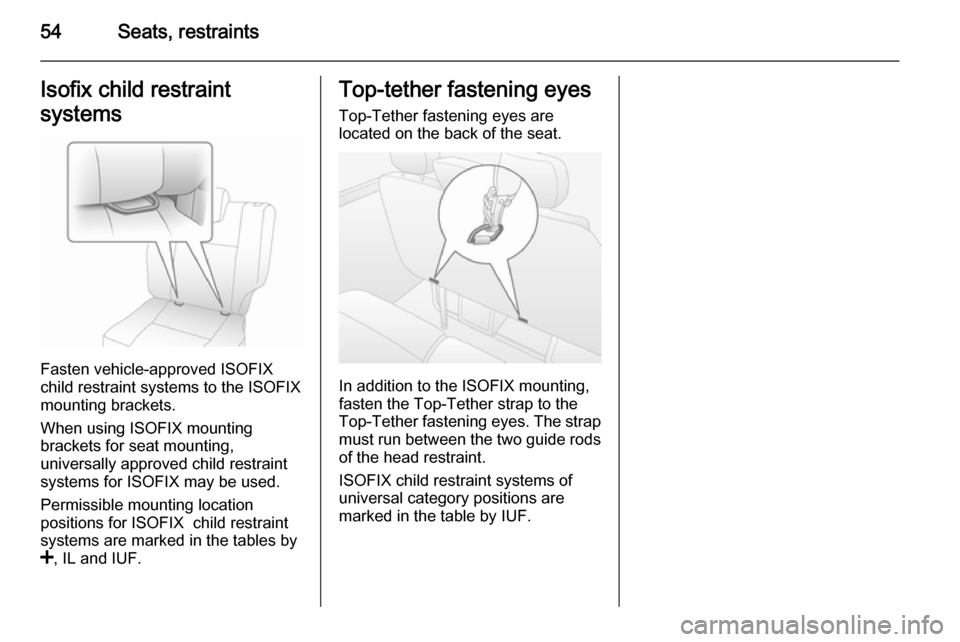
54Seats, restraintsIsofix child restraint
systems
Fasten vehicle-approved ISOFIX
child restraint systems to the ISOFIX
mounting brackets.
When using ISOFIX mounting
brackets for seat mounting,
universally approved child restraint
systems for ISOFIX may be used.
Permissible mounting location
positions for ISOFIX child restraint
systems are marked in the tables by
< , IL and IUF.
Top-tether fastening eyes
Top-Tether fastening eyes are
located on the back of the seat.
In addition to the ISOFIX mounting,
fasten the Top-Tether strap to the
Top-Tether fastening eyes. The strap
must run between the two guide rods
of the head restraint.
ISOFIX child restraint systems of
universal category positions are
marked in the table by IUF.
Page 57 of 173
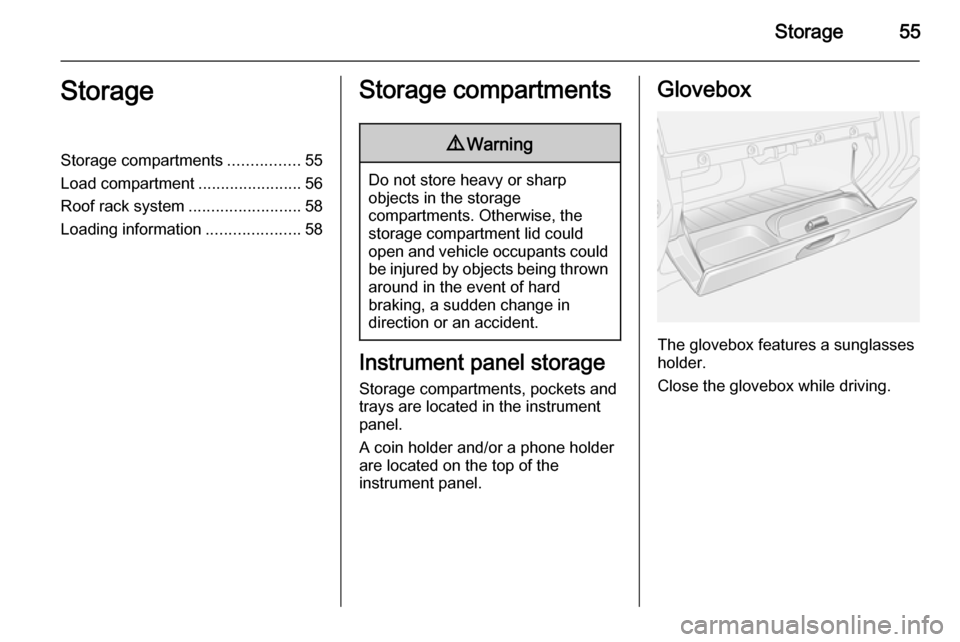
Storage55StorageStorage compartments................55
Load compartment .......................56
Roof rack system .........................58
Loading information .....................58Storage compartments9Warning
Do not store heavy or sharp
objects in the storage
compartments. Otherwise, the
storage compartment lid could
open and vehicle occupants could be injured by objects being thrown
around in the event of hard
braking, a sudden change in
direction or an accident.
Instrument panel storage
Storage compartments, pockets and
trays are located in the instrument
panel.
A coin holder and/or a phone holder
are located on the top of the
instrument panel.
Glovebox
The glovebox features a sunglasses
holder.
Close the glovebox while driving.
Page 58 of 173
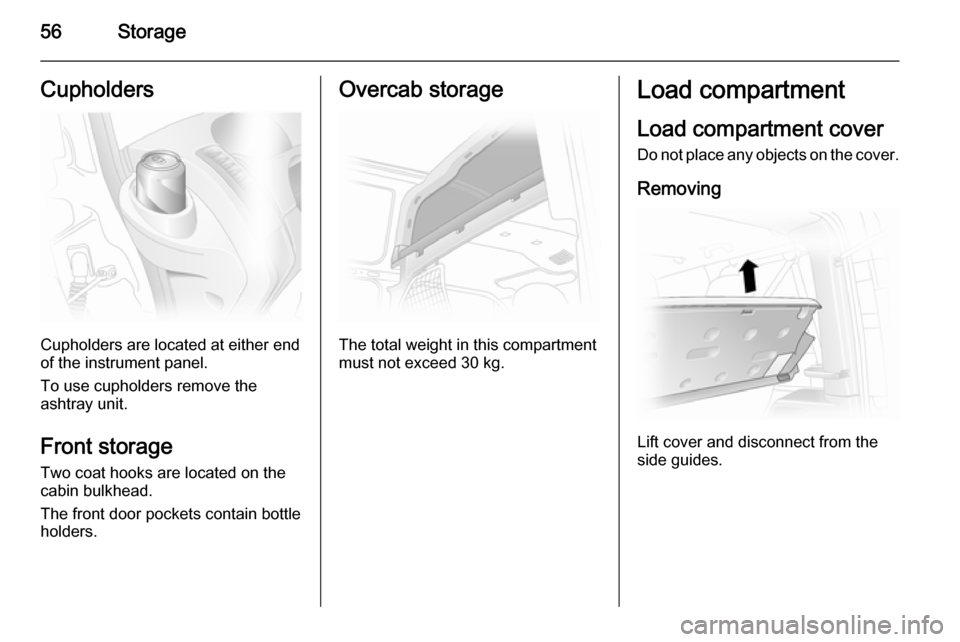
56StorageCupholders
Cupholders are located at either end
of the instrument panel.
To use cupholders remove the
ashtray unit.
Front storage
Two coat hooks are located on the cabin bulkhead.
The front door pockets contain bottle
holders.
Overcab storage
The total weight in this compartment
must not exceed 30 kg.
Load compartment
Load compartment cover Do not place any objects on the cover.
Removing
Lift cover and disconnect from the
side guides.
Page 59 of 173
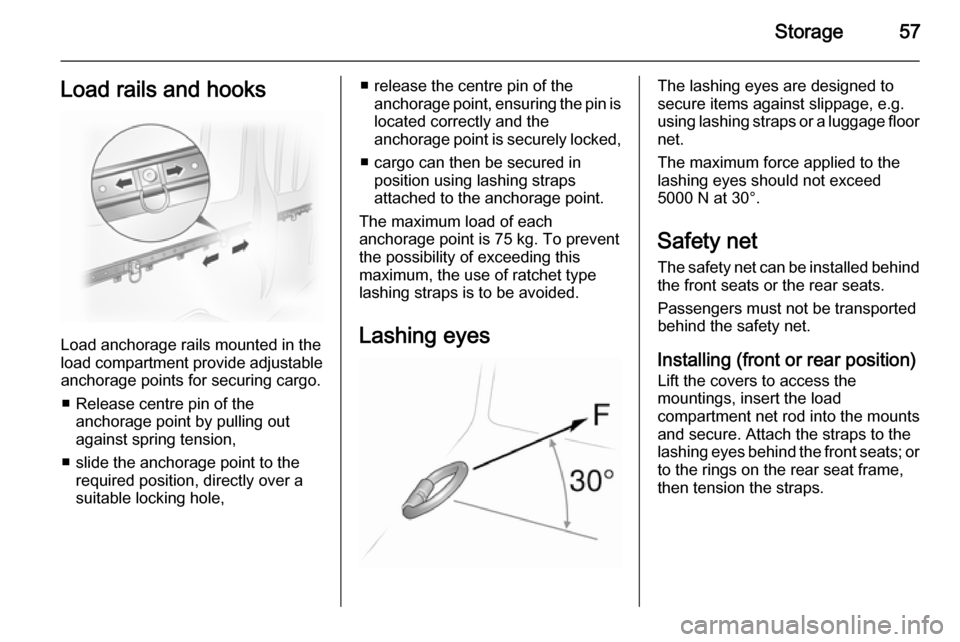
Storage57Load rails and hooks
Load anchorage rails mounted in the
load compartment provide adjustable anchorage points for securing cargo.
■ Release centre pin of the anchorage point by pulling out
against spring tension,
■ slide the anchorage point to the required position, directly over a
suitable locking hole,
■ release the centre pin of the anchorage point, ensuring the pin islocated correctly and the
anchorage point is securely locked,
■ cargo can then be secured in position using lashing straps
attached to the anchorage point.
The maximum load of each
anchorage point is 75 kg. To prevent
the possibility of exceeding this
maximum, the use of ratchet type
lashing straps is to be avoided.
Lashing eyesThe lashing eyes are designed to
secure items against slippage, e.g.
using lashing straps or a luggage floor
net.
The maximum force applied to the
lashing eyes should not exceed
5000 N at 30°.
Safety net
The safety net can be installed behind the front seats or the rear seats.
Passengers must not be transported
behind the safety net.
Installing (front or rear position) Lift the covers to access the
mountings, insert the load
compartment net rod into the mounts
and secure. Attach the straps to the
lashing eyes behind the front seats; or
to the rings on the rear seat frame,
then tension the straps.
Page 60 of 173
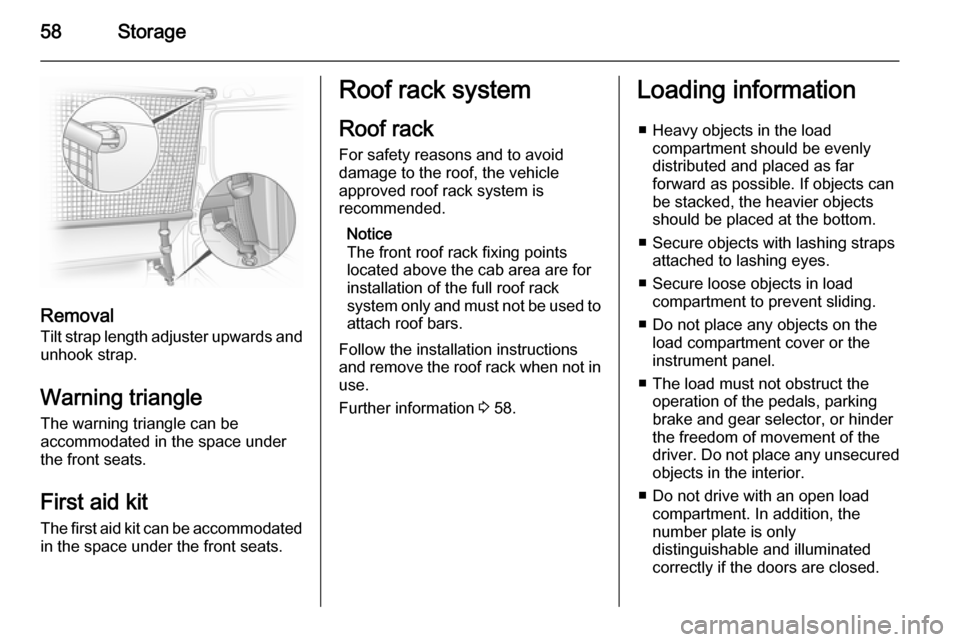
58Storage
Removal
Tilt strap length adjuster upwards and unhook strap.
Warning triangleThe warning triangle can be
accommodated in the space under
the front seats.
First aid kit
The first aid kit can be accommodated
in the space under the front seats.
Roof rack system
Roof rack For safety reasons and to avoiddamage to the roof, the vehicle
approved roof rack system is
recommended.
Notice
The front roof rack fixing points
located above the cab area are for
installation of the full roof rack
system only and must not be used to attach roof bars.
Follow the installation instructions
and remove the roof rack when not in
use.
Further information 3 58.Loading information
■ Heavy objects in the load compartment should be evenly
distributed and placed as far
forward as possible. If objects can
be stacked, the heavier objects
should be placed at the bottom.
■ Secure objects with lashing straps attached to lashing eyes.
■ Secure loose objects in load compartment to prevent sliding.
■ Do not place any objects on the load compartment cover or theinstrument panel.
■ The load must not obstruct the operation of the pedals, parking
brake and gear selector, or hinder
the freedom of movement of the
driver. Do not place any unsecured objects in the interior.
■ Do not drive with an open load compartment. In addition, the
number plate is only
distinguishable and illuminated
correctly if the doors are closed.